Discover 35 hidden attractions, cool sights, and unusual things to do in Seattle (United States). Don't miss out on these must-see attractions: Seattle Center, Space Needle, and Museum of Flight. Also, be sure to include Seattle Art Museum in your itinerary.
Below, you can find the list of the most amazing places you should visit in Seattle (Washington).
Table of Contents
Seattle Center
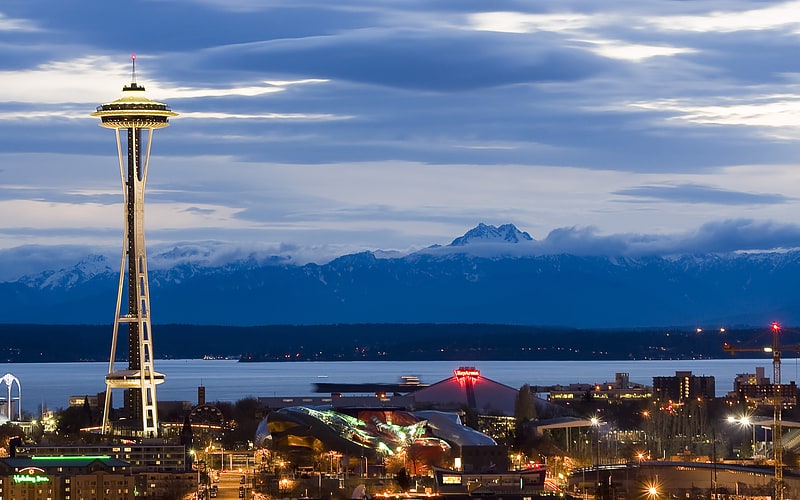
Building complex in Seattle, Washington. Seattle Center is an arts, educational, tourism and entertainment center in Seattle, Washington, United States. Spanning an area of 74 acres, it was originally built for the 1962 World's Fair. Its landmark feature is the 605 ft tall Space Needle, which at the time of its completion was the tallest building west of the Mississippi River. Seattle Center is located just north of Belltown in the Uptown neighborhood.[1]
Address: 305 Harrison St, 98109 Seattle
Space Needle
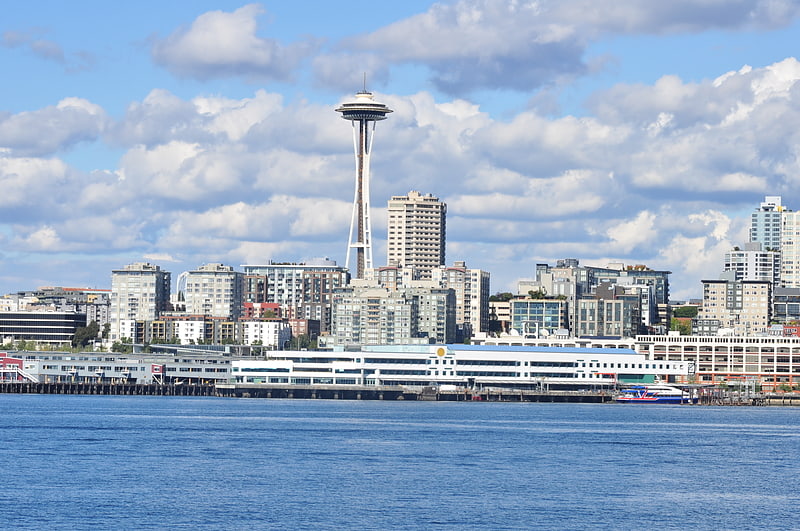
Landmark modern spire with city vistas. The Space Needle is an observation tower in Seattle, Washington, United States. Considered to be an icon of the city, it has been designated a Seattle landmark. Located in the Lower Queen Anne neighborhood, it was built in the Seattle Center for the 1962 World's Fair, which drew over 2.3 million visitors.
The Space Needle was once the tallest structure west of the Mississippi River, standing at 605 ft (184 m). The tower is 138 ft (42 m) wide, weighs 9,550 short tons (8,660 metric tons), and is built to withstand winds of up to 200 mph (320 km/h) and earthquakes of up to 9.0 magnitude, as strong as the 1700 Cascadia earthquake.
The Space Needle features an observation deck 520 ft (160 m) above ground, providing views of the downtown Seattle skyline, the Olympic and Cascade Mountains, Mount Rainier, Mount Baker, Elliott Bay, and various islands in Puget Sound. Visitors can reach the top of the Space Needle by elevators. It takes 41 seconds to reach the top in the elevators. On April 19, 1999, the city's Landmarks Preservation Board designated the tower a historic landmark.[2]
Address: 400 Broad St, 98109 Seattle
Museum of Flight
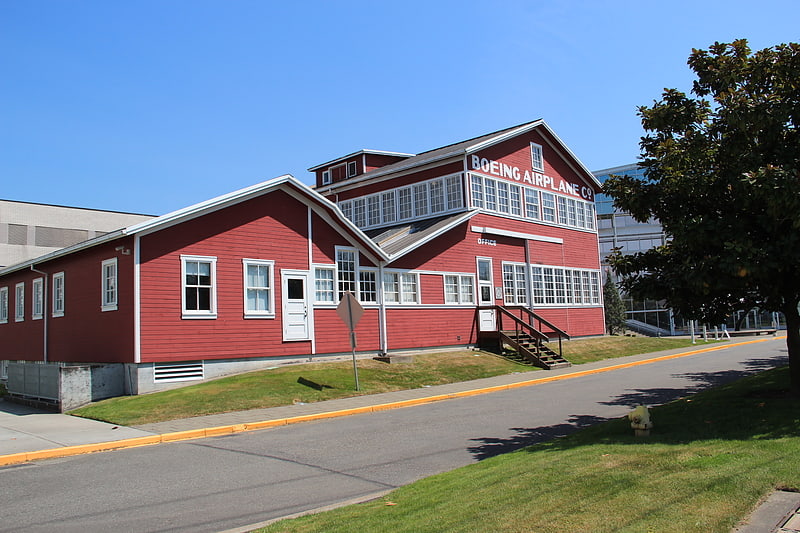
Exhibits with airplanes and space vehicles. The Museum of Flight is a private non-profit air and space museum in the Seattle metropolitan area. It is located at the southern end of King County International Airport in the city of Tukwila, immediately south of Seattle. It was established in 1965 and is fully accredited by the American Alliance of Museums. As the largest private air and space museum in the world, it also hosts large K–12 educational programs.
The museum attracts over 500,000 visitors every year, and also serves more than 140,000 students annually through its onsite programs: a Challenger Learning Center, an Aviation Learning Center, and a summer camp, as well as outreach programs that travel throughout Washington and Oregon.[3]
Address: 9404 E Marginal Way S, 98108 Seattle (Greater Duwamish)
Seattle Art Museum

Spacious home for modern and historic work. The Seattle Art Museum is an art museum located in Seattle, Washington, United States. It operates three major facilities: its main museum in downtown Seattle; the Seattle Asian Art Museum in Volunteer Park on Capitol Hill, and Olympic Sculpture Park on the central Seattle waterfront, which opened in January 2007.[4]
Address: 1300 1st Ave, 98101 Seattle (Downtown Seattle)
Burke Museum
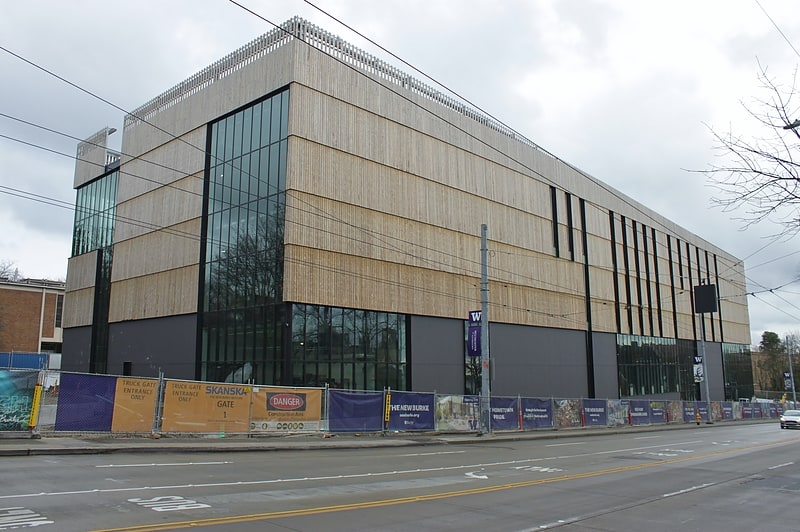
Museum with regional artifacts. The Burke Museum of Natural History and Culture is a natural history museum in Seattle, Washington, in the United States. Established in 1899 as the Washington State Museum, it traces its origins to a high school naturalist club formed in 1879. The museum is the oldest in Washington state and boasts a collection of more than 16 million artifacts, including the world's largest collection of spread bird wings. Located on the campus of the University of Washington, the Burke Museum is the official state museum of Washington.[5]
Address: 1413 NE 45th St, 98105 Seattle (Northeast Seattle)
Museum of Pop Culture

Experience Music Project. The Museum of Pop Culture or MoPOP is a nonprofit museum in Seattle, Washington, dedicated to contemporary popular culture. It was founded by Microsoft co-founder Paul Allen in 2000 as the Experience Music Project. Since then MoPOP has organized dozens of exhibits, 17 of which have toured across the U.S. and internationally.
The museum—formerly known as Experience Music Project and Science Fiction Museum and Hall of Fame (EMP|SFM) and later EMP Museum until November 2016—has initiated many public programs including "Sound Off!", an annual 21-and-under battle-of-the-bands that supports the all-ages scene; and "Pop Conference", an annual gathering of academics, critics, musicians, and music buffs.
MoPOP, in collaboration with the Seattle International Film Festival (SIFF), presents the Science Fiction and Fantasy Short Film Festival which takes place every winter at Seattle Cinerama Theater. Since 2007, the MoPop celebrates recording artists with the Founders Award for their noteworthy contributions.[6]
Address: 325 5th Ave N, 98109-4630 Seattle
Seattle Aquarium
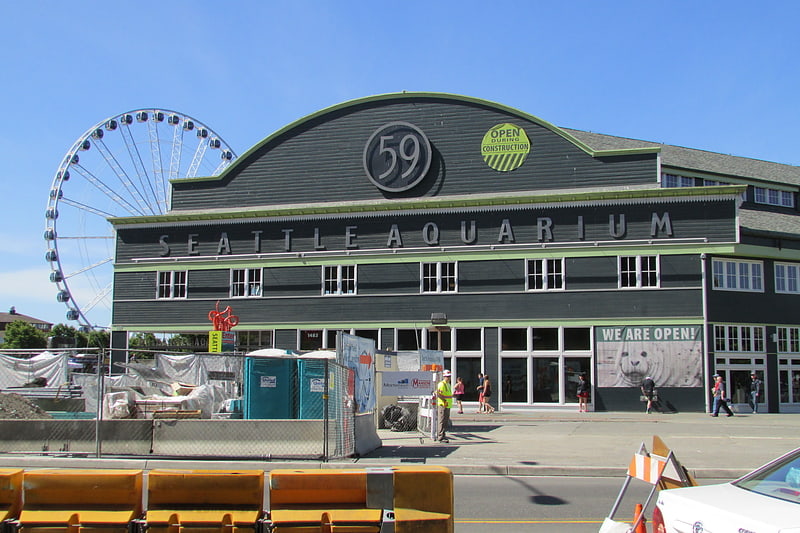
Sea life plus an underwater viewing dome. The Seattle Aquarium is a public aquarium in Seattle, Washington, United States, located on Pier 59 on the Elliott Bay waterfront. It opened in 1977 and has been accredited by the Association of Zoos and Aquariums.[7]
Address: 1483 Alaskan Way, 98101-2015 Seattle (Downtown Seattle)
Pacific Science Center
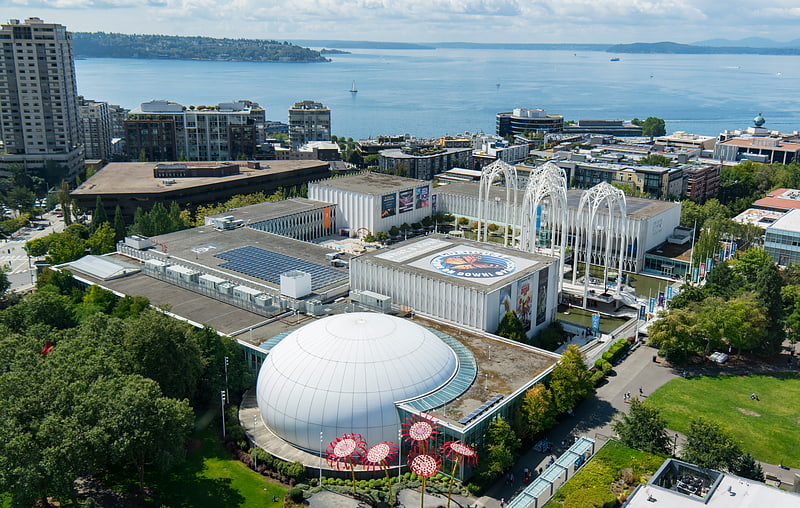
Museum with immersive rotating exhibits. Pacific Science Center is an independent, non-profit science center in Seattle with a mission to ignite curiosity and fuel a passion for discovery, experimentation, and critical thinking. Pacific Science Center serves more than 1 million people each year at its campus adjacent to Seattle Center, at the Mercer Slough Environmental Education Center in Bellevue, Washington, and in communities and classrooms across the state of Washington.[8]
Address: 200 2nd Ave N, 98109-4895 Seattle
Olympic Sculpture Park
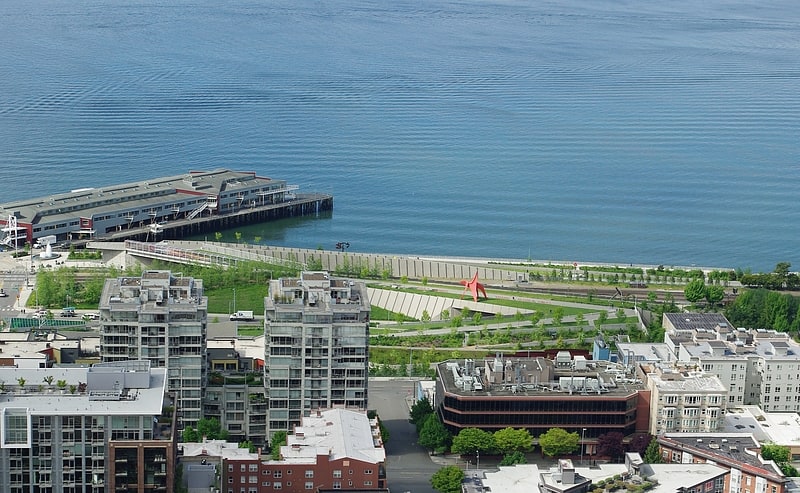
Museum in Seattle, Washington. The Olympic Sculpture Park, created and operated by the Seattle Art Museum, is a public park with modern and contemporary sculpture in downtown Seattle, Washington. The park, which opened January 20, 2007, consists of a 9-acre outdoor sculpture museum, and indoor pavilion, and a beach on Puget Sound. It is situated in Belltown at the northern end of the Central Waterfront and the southern end of Myrtle Edwards Park.
The Olympic Sculpture Park is a free-admission outdoor sculpture park with both permanent outdoor sculpture, temporary works, and site-specific installations. The Seattle Art Museum regularly rotates a major artwork at the Olympic Sculpture Park, including installations by Victoria Haven from 2016 - 2017, Spencer Finch from 2017 - 2019, and Regina Silveira from 2019 - 2020.[9]
Address: 2901 Western Ave, 98121-1025 Seattle (Downtown Seattle)
Fishermen's Terminal
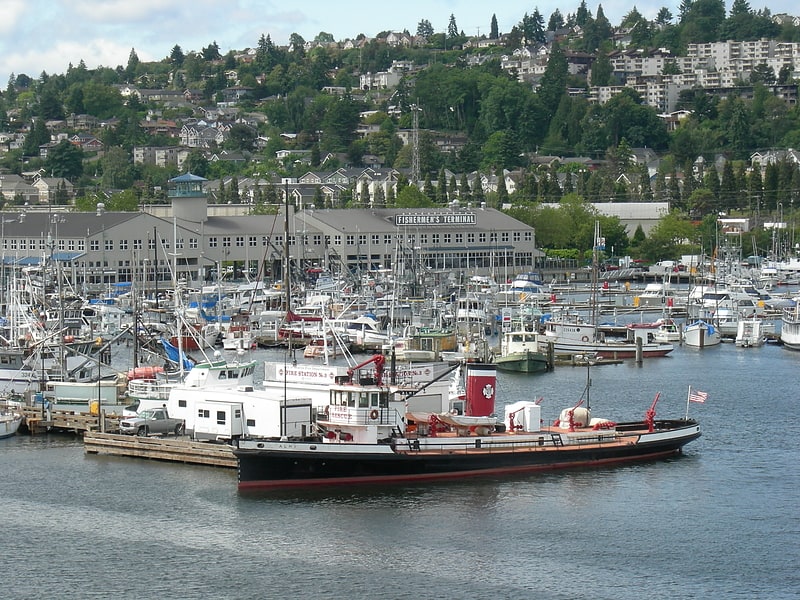
Fishermen's Terminal is a dock opened in 1914 and operated by the Port of Seattle as the home port for Seattle's commercial fishing fleet, and, since 2002, non-commercial pleasure craft. The Terminal is on Salmon Bay in the Interbay neighborhood, east of the Hiram M. Chittenden Locks and immediately west of the Ballard Bridge.
The Terminal has freshwater mooring for fishing vessels and pleasure craft up to 250 ft (76 m) length. Preference is given to commercial fishing vessels. It serves more than 700 vessels. A public access float provides free moorage for up to four hours for visitors. The facility also includes 227,000 square feet (21,100 m2) of office, retail, restaurant, light industry and warehouse space. There are two restaurants, a seafood market, a bookstore and a gift shop.
Fisherman's Terminal is home to some of the vessels in the Discovery Channel TV series Deadliest Catch. It was also the topic of a documentary film Fishermen's Terminal. The documentary centers on the conflict between the moorage needs of the fishing fleet and pleasure boaters.
The Seattle Fishermen's Memorial faces the water between the docks and the Terminal building. It is bronze and stone sculpture with plaques memorializing more than 670 local commercial fishermen and women who have been lost at sea since the beginning of the 20th century. The memorial is managed by its own non-profit organization. Since 1988, the Terminal has hosted the annual Fishermen's Fall Festival for the return of the North Pacific fishing fleet.[10]
Address: 3919 18th Ave W, 98119-1679 Seattle
Gas Works Park
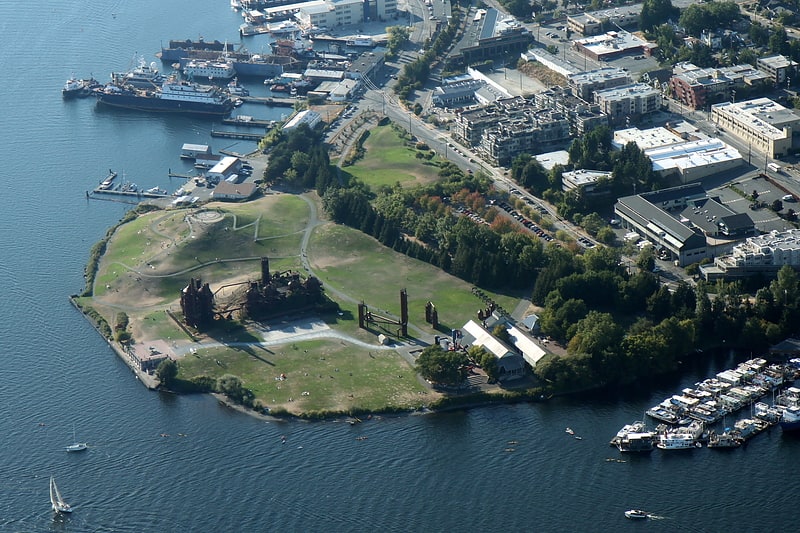
Sweeping city views from a picnic spot. Gas Works Park is a park located in Seattle, Washington, United States. It is a 19.1-acre public park on the site of the former Seattle Gas Light Company gasification plant, located on the north shore of Lake Union at the south end of the Wallingford neighborhood. The park was added to the National Register of Historic Places on January 2, 2013, over a decade after being nominated.
Gas Works Park contains remnants of the sole remaining coal gasification plant in the United States. The plant operated from 1906 to 1956 and was bought by the city of Seattle for park purposes in 1962. The park opened to the public in 1975; it was designed by Seattle landscape architect Richard Haag, who won the American Society of Landscape Architects Presidents Award of Design Excellence for the project. The plant's conversion into a park was completed by Daviscourt Construction Company of Seattle. It was originally named Myrtle Edwards Park, after the city councilwoman who had spearheaded the drive to acquire the site, who died in a car crash in 1969. In 1972, the Edwards family requested that her name be removed from that of the park because the design called for the retention of much of the plant. In 1976, Elliott Bay Park (just north of Seattle's Belltown neighborhood) was renamed Myrtle Edwards Park.[11]
Address: 3300 Meridian Ave N, 98103-9150 Seattle (Lake Union)
Lake Union
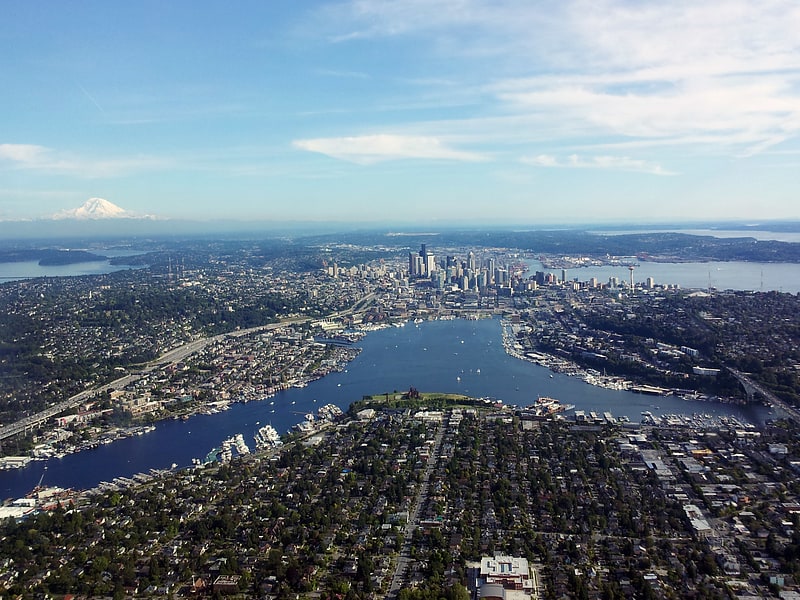
Scenic waters for recreational boating. Lake Union is a freshwater lake located entirely within the city limits of Seattle, Washington, United States. It is a major part of the Lake Washington Ship Canal. The easternmost point of the lake is the Ship Canal Bridge, which carries Interstate 5 over the eastern arm of the lake and separates Lake Union from Portage Bay. Lake Union is the namesake of the neighborhoods located on its east and west shores: Eastlake and Westlake respectively. The northern shore of the lake is home to Gas Works Park. Notable features of the southern area of the lake—collectively known as the South Lake Union district—include Lake Union Park, Museum of History & Industry, and the Center for Wooden Boats.
The George Washington Memorial Bridge (also known as the Aurora Bridge) carries State Route 99 over the western arm of Lake Union. The Aurora Bridge is so named because it carries Aurora Ave N down the western side of the lake. Lake Union's westernmost point can be considered the Fremont Cut, which is located just west of the Aurora Bridge and is spanned by the Fremont Bridge. The Fremont Bridge carries Fremont Ave N between the neighborhoods of Fremont and Queen Anne and separates Lake Union from the rest of the Lake Washington Ship Canal to the west.[12]
Lake Union Park

Park in Seattle, Washington. Lake Union Park is a 12-acre park located at the south end of Lake Union in Seattle, Washington in the South Lake Union neighborhood. The park is owned by the City of Seattle and operated by Seattle Parks and Recreation. The park property was gradually acquired by the City, and the final 5 acres were transferred from the United States Navy to the City of Seattle on July 1, 2000. After renovation, the current park space officially opened on September 25, 2010.[13]
Address: 860 Terry Ave N, 98109-4330 Seattle (Cascade)
Seattle Japanese Garden
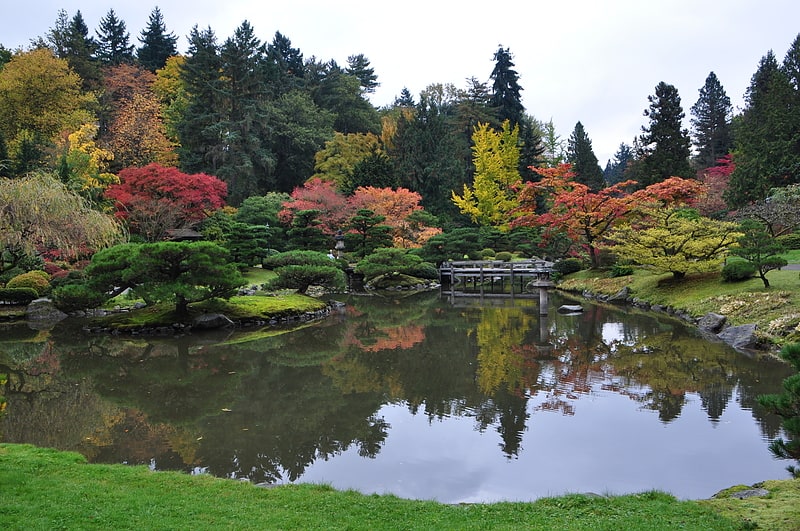
Garden in Seattle, Washington. The Seattle Japanese Garden is a 3.5 acre Japanese garden in the Madison Park neighborhood of Seattle. The garden is located in the southern end of the Washington Park Arboretum on Lake Washington Boulevard East. The garden is one of the oldest Japanese gardens in North America, and is regarded as one of the most authentic Japanese gardens in the United States.[14]
Address: 1075 Lake Washington Blvd E, 98112-3755 Seattle (Capitol Hill)
Seattle Asian Art Museum
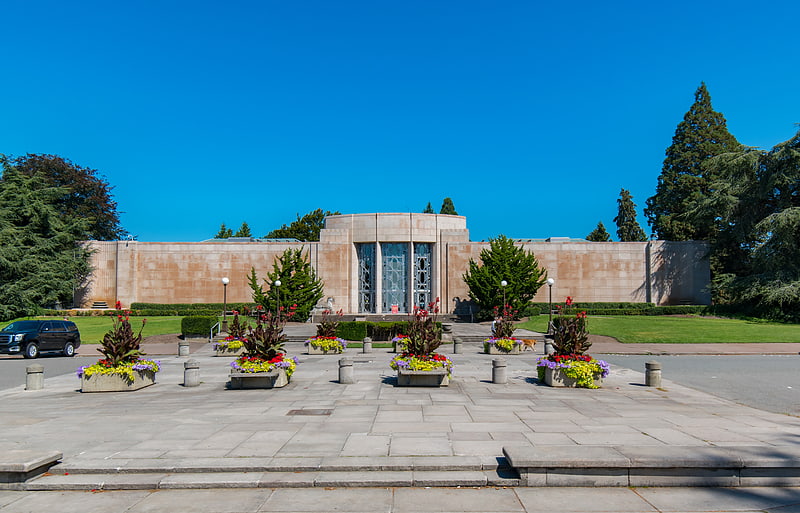
Asian art in a 1930s art deco building. The Seattle Asian Art Museum is a museum of Asian art at Volunteer Park in the Capitol Hill neighborhood of Seattle, Washington, United States. Part of the Seattle Art Museum, the SAAM exhibits historic and contemporary artworks from China, Korea, Japan, India, the Himalayas, and other Southeast Asian countries. It also features an education center, conservation center, and library. The museum is located in the 1933 Art Deco building which was originally home to the Seattle Art Museum's main collection. In 1991 the main collection moved to a newly constructed Seattle Art Museum building in the downtown area. The Seattle Asian Art Museum opened in 1994.[15]
Address: Volunteer Park, 98112 Seattle (Capitol Hill)
Woodland Park Zoo
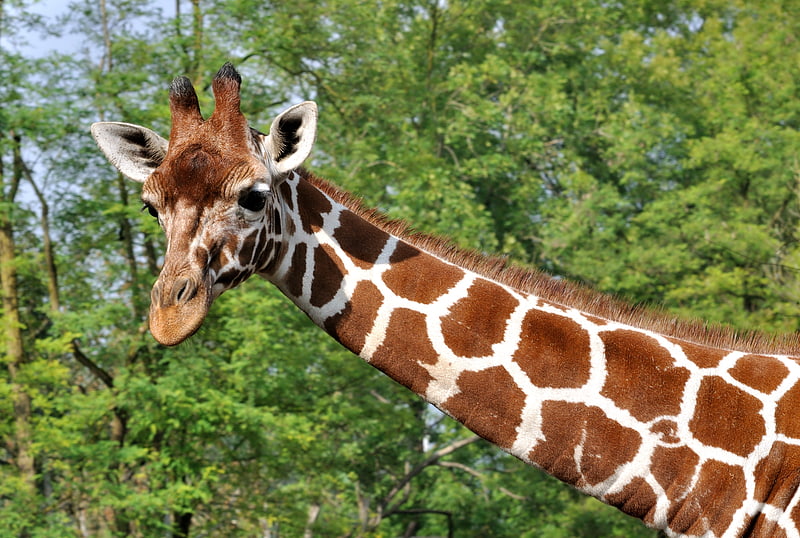
Conservation-focused 92-acre attraction. Woodland Park Zoo is a wildlife conservation organization and zoological garden located in the Phinney Ridge neighborhood of Seattle, Washington, United States. It is the recipient of over 65 awards across multiple categories, and had served approximately 1.4 million domestic and international visitors in 2019.[16]
Address: 5500 Phinney Ave N, 98103-5897 Seattle (Northwest Seattle)
Broken Obelisk
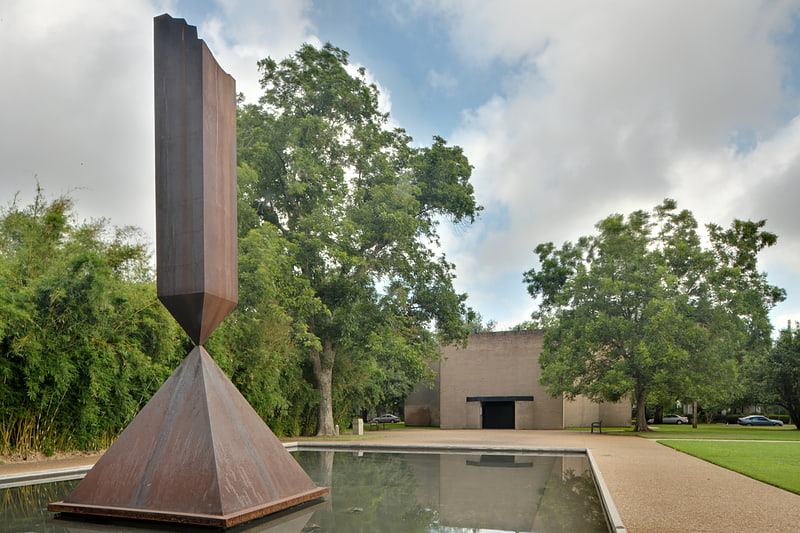
Broken Obelisk is a sculpture designed by Barnett Newman between 1963 and 1967. Fabricated from three tons of Cor-Ten steel, which acquires a rust-colored patina, it is the largest and best known of his six sculptures.
Four multiples of the sculpture exist. Recent articles regarding this sculpture contradict one another with regard to the individual histories of its first three multiples. The following entry attempts to resolve these contradictions, but further research of primary sources (1967–1971) is required to track the history of each one more accurately.
The first two multiples of the sculpture were fabricated by Lippincott, Inc. in North Haven, Connecticut in 1966–67. The sculpture first appeared on display outside the Corcoran Gallery of Art in Washington, D.C. (as part of an exhibit titled "Scale and Content" (1967), which included Tony Smith's Smoke and Glass and Ronald Bladen's The X), and in front of the Seagram Building in New York City. Broken Obelisk generated some controversy in Washington, as it appeared to be a reference to a broken upside-down Washington Monument at a time of civil unrest. When Corcoran director James Harithas resigned in 1969, Barnett Newman had the sculpture removed.
A third multiple, which included some internal, structural improvements, was completed in 1969 by Lippincott, Inc. which became part of the permanent collection of the Museum of Modern Art in New York City. For a short period of time in 1969–70, the first three multiples of this sculpture sat side by side at the Lippincott, Inc. foundry in North Haven. One was secured by John de Menil with a matching grant from the National Foundation for the Arts and Humanities and was installed on the grounds of the Rothko Chapel in Houston in 1970, surrounded by a reflecting pool. As a condition set by de Menil, the sculpture in Houston is dedicated to Martin Luther King Jr. Virginia Wright secured another multiple, which was installed in Red Square on the campus of the University of Washington in Seattle in 1971.
With the permission of the Barnett Newman Foundation, a fourth multiple was commissioned in 2003 and completed in 2005–06 by Lippincott, Merrifield, and Roberts. This last of the four multiples was installed in front of the Neue Nationalgalerie in Berlin in 2007–08 and later acquired by Storm King Art Center. In the summer of 2014, all four multiples were on display in the United States at the following locations: Rothko Chapel, Houston; Red Square, University of Washington, Seattle; Museum of Modern Art, New York City; and Storm King Art Center, New Windsor, New York.
Art critic Robert Hughes, writing on Broken Obelisk in 1971, said:
Newman's pursuit of the sublime lay less in nature than in culture. This enabled him to pick ancient, man-made forms and return them to pristine significance without a trace of piracy. One index of that ability was his sculpture. Broken Obelisk, perhaps the best American sculpture of its time, is Newman's meditation on ancient Egypt: a steel pyramid, from whose apex an inverted obelisk rises like a beam of light. Here, Newman bypassed the Western associations of pyramids and broken columns with death, and produced a life-affirming image of transcendence. That unruffled self-sufficiency, beyond style, gave Newman's work its mysterious didactic value. It is not 'expressive'; the silence at the core bespeaks a man for whom art was a philosophical activity, a way of knowledge.[17]
Washington Park Arboretum
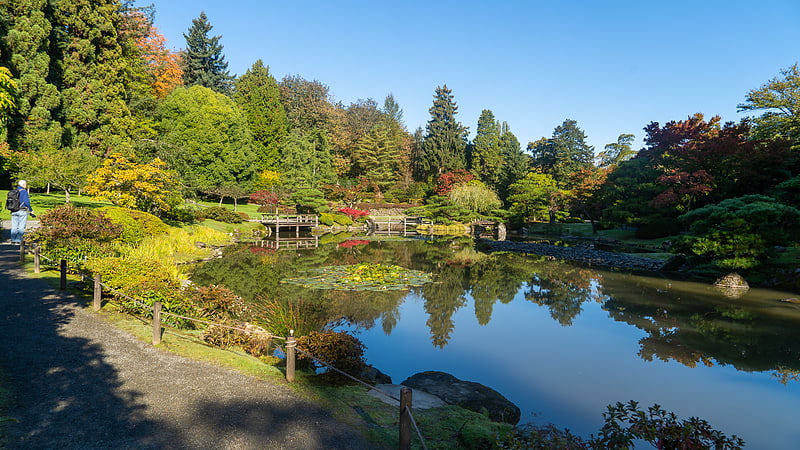
Botanical garden in Seattle, Washington. Washington Park is a public park in Seattle, Washington, United States, most of which is taken up by the Washington Park Arboretum, a joint project of the University of Washington, the Seattle Parks and Recreation, and the nonprofit Arboretum Foundation. Washington Park also includes a playfield and the Seattle Japanese Garden in its southwest corner.
To the north is Union Bay; to the west are Montlake and Madison Valley; to the south is the Washington Park neighborhood; and to the east is the Broadmoor Golf Club.
Lake Washington Boulevard E. runs north and south through the park, parallel to the creek. A secondary road, for most of its length named Arboretum Drive E. and for a short northern stretch named E. Foster Island Road, runs along the Arboretum's eastern edge. E. Interlaken Boulevard and Boyer Avenue E. run northwest out of the park to Montlake and beyond. State Route 520 cuts through Foster Island and the Union Bay wetlands at the park's northern end, interchanging with Lake Washington Boulevard just outside the arboretum entrance. A footpath winds underneath the freeway overpasses and over boardwalks, along the Lake Washington ship canal, and into the gardens of the Arboretum.
The Arboretum is well known for Azalea Way in the springtime, a stretch of the park which offers a unique tapestry of azaleas of many colors. The area is a popular site for strolling and is utilized by photographers and artists. The manicured Azalea Way stands out in stark contrast with the Arboretum's wild and heavily canopied areas.
The land occupied by the Washington Park Arboretum has been developed and is owned by the city, but the Arboretum is operated primarily by the University of Washington.
Arboretum Creek is approximately 4,000 feet (1,200 m) long, entirely within the park. Its average channel width is 4 feet (1.2 m) and its average channel depth is 2 feet (0.61 m). The creek's source is a spring-fed stream in the Alder Creek Natural Area, three publicly owned properties on 26th Ave East between East Helen and Prospect streets. The stream feeds the koi pond in Washington Park's Japanese Garden, near the playfield at the park's southern end. It also receives runoff from Rhododendron Glen and the Woodland Garden, as well as sub-surface drainage from the neighboring course of the Broadmoor Golf Club. It empties into Lake Washington via Willow Bay, itself a minor arm of Union Bay, having passed through numerous culverts under Lake Washington Boulevard.[18]
Address: 2300 Arboretum Dr E, 98112 Seattle (Capitol Hill)
Living Computers: Museum + Labs
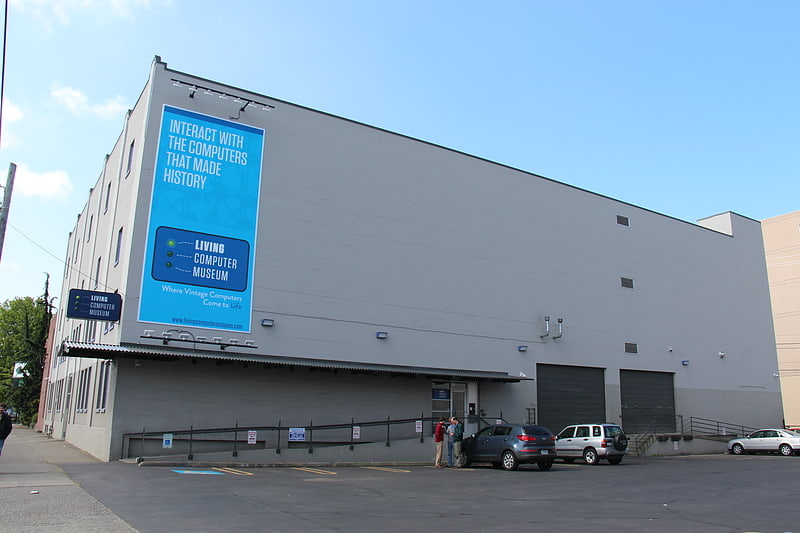
Living Computers: Museum + Labs is a computer and technology museum located in the SoDo neighborhood of Seattle, Washington. LCM+L showcases vintage computers which provide interactive sessions, either through time-sharing operating systems or single-user interfaces. This gives users a chance to actually use the computers online or in-person in the museum. An expansion adds direct touch experiences with contemporary technologies such as self-driving cars, the internet of things, big data, and robotics. This puts today's computer technology in the context of how it's being used to tackle real-world issues. LCM+L also hosts a wide range of educational programs and events in their state-of-the art classroom and lab spaces.
According to an archived version of LCM's website, their goal is "to breathe life back into our machines so the public can experience what it was like to see them, hear them, and interact with them. We make our systems accessible by allowing people to come and interact with them, and by making them available over the Internet."
The current site similarly shares that "Living Computers: Museum + Labs provides a one-of-a-kind, hands-on experience with computer technology from the 1960s to the present. LCM+L honors the history of computing with the world’s largest collection of fully restored—and usable—supercomputers, mainframes, minicomputers and microcomputers."
As of August 2020, the museum is closed due to the COVID-19 pandemic.[19]
Address: 2245 1st Ave S, 98134-1407 Seattle (Greater Duwamish)
Pike Place Chowder
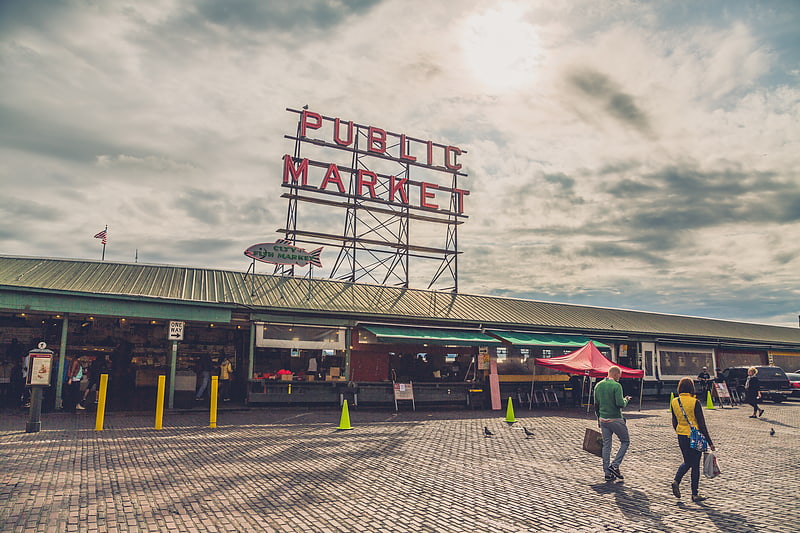
Pike Place Fish Market is an open-air fish market at Pike Place Market in Seattle, Washington, United States, located at the corner of Pike Street and Pike Place. Founded in 1930, it is known for its tradition of fishmongers throwing the fish purchased by customers prior to wrapping it. The fish market was near to bankruptcy in 1986, but after the introduction of new practices such as the fish throwing, games, and customer performances, it received significant exposure in national media and on television shows. Pike Place Fish Market is today a world-famous tourist destination, attracting up to 10,000 daily visitors.[20]
Address: 1530 Post Alley, Seattle (Downtown Seattle)
Discovery Park
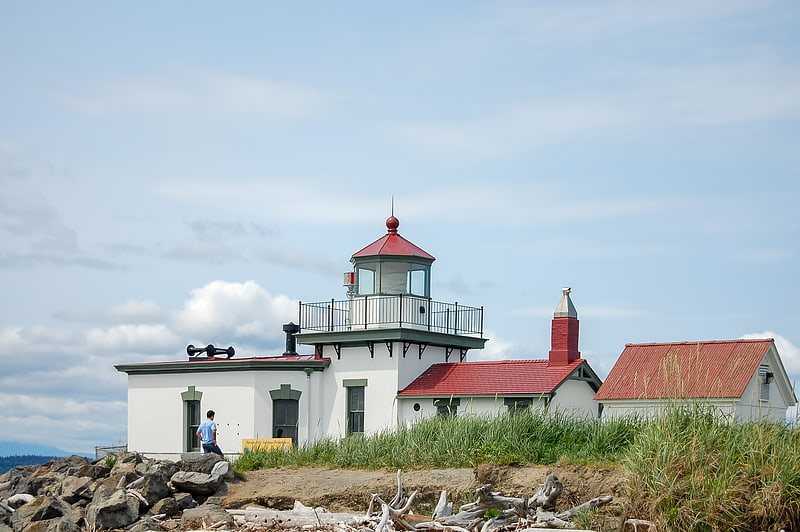
Park in Seattle, Washington. Discovery Park is a 534-acre park on the shores of Puget Sound in the Magnolia neighborhood of Seattle, Washington. As the city's largest public park, it contains 11.81 miles of walking trails. Daybreak Star Cultural Center is within the park's boundaries. A lighthouse is located on West Point, the westernmost point of the park and the entire city of Seattle, and on the south side of the North Beach strip is a sewage treatment plant, but it is almost entirely concealed from the marsh, beach, and trail. The Discovery Park Loop Trail, designated a National Recreation Trail in 1975, runs 2.8 miles through the park, connecting to other trails.
The park is built on the historic grounds of Fort Lawton; most of the Fort Lawton Historic District (FLHD) falls within the park (although an enclave within the district remains in military hands), as does the West Point Lighthouse. Both the FLHD and the lighthouse are on the National Register of Historic Places.
Forests, beaches, prairies, and bluffs dominate the landscape of the park.[21]
Address: 3801 Discovery Park Blvd, 98199 Seattle
Smith Tower
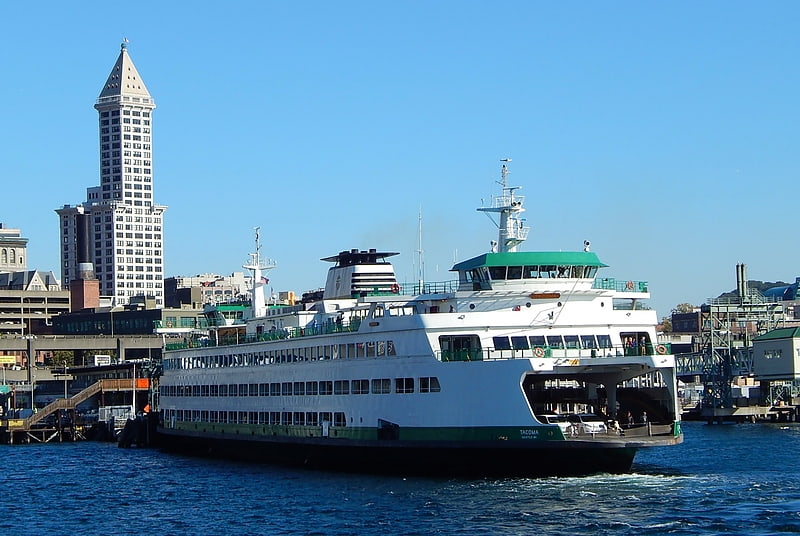
Historic site with views and a vintage bar. Smith Tower is a skyscraper in the Pioneer Square neighborhood of Seattle, Washington, United States. Completed in 1914, the 38-story, 484 ft tower is the oldest skyscraper in the city and was among the tallest skyscrapers outside New York City at the time of its completion. It was the tallest building west of the Mississippi River until the completion of the Kansas City Power & Light Building in 1931. It remained the tallest building on the U.S. West Coast for nearly half a century, until the Space Needle overtook it in 1962.
The tower is named after its builder, the firearm and typewriter magnate Lyman Cornelius Smith (unrelated to Horace Smith of Smith & Wesson), but its construction was largely overseen by his son Burns Lyman Smith after his father's 1910 death and would remain under the ownership of the Smith family into the 1940s. It was originally known as the L.C. Smith Building until the Smith Tower became its official name in 1929. It was designated as a Seattle landmark in 1984.[22]
Address: 506 2nd Ave, 98104 Seattle (Downtown Seattle)
Volunteer Park
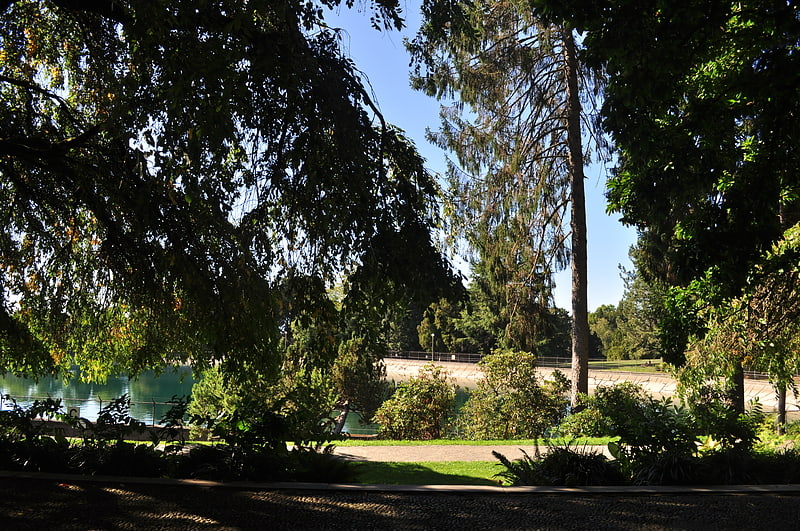
Park in Seattle, Washington. Volunteer Park is a 48.3-acre park in the Capitol Hill neighborhood of Seattle, Washington, United States.[23]
Address: 1247 15th Ave E, 98112-3341 Seattle (Capitol Hill)
Pioneer Square totem pole
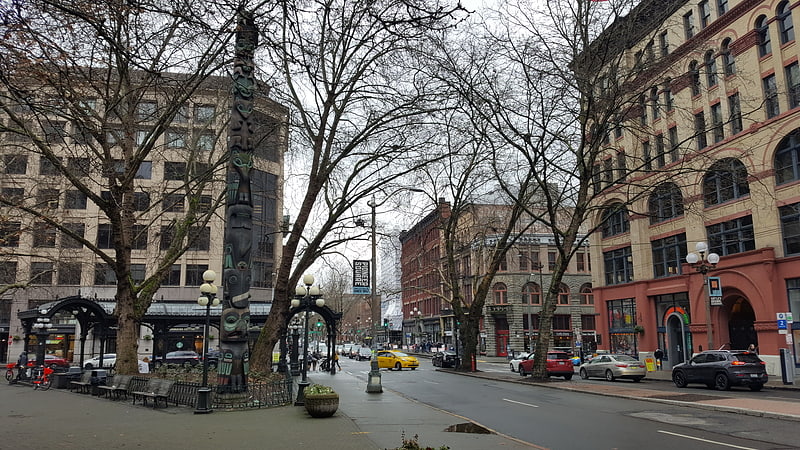
The Pioneer Square totem pole, also referred to as the Seattle totem pole and historically as the Chief-of-All-Women pole, is a Tlingit totem pole located in Pioneer Square in downtown Seattle, Washington.
The original totem pole was carved in 1790 and raised in the Tlingit village on Tongass Island, Alaska to honor the Tlingit woman Chief-of-All-Women. The totem pole was later stolen by Seattle businessmen on an expedition to Alaska and subsequently gifted to the City of Seattle in 1899, where it was raised in Pioneer Square and became a source of civic pride. The totem pole was later damaged by arson and a replica was commissioned and installed in its place in 1940, which is now designated a National Historic Landmark.[24]
Address: 627 1st Avenue, Seattle (Downtown Seattle)
Freeway Park

Park in Seattle, Washington. Freeway Park, officially known as Jim Ellis Freeway Park, is an urban park in Seattle, Washington, United States, connecting the city's downtown to the Washington State Convention Center and First Hill. The park sits atop a section of Interstate 5 and a large city-owned parking lot; 8th Avenue also bridges over the park. An unusual mixture of brutalist architecture and greenery, the 5.2-acre park, designed by Lawrence Halprin's office under the supervision of Angela Danadjieva, opened to the public on July 4, 1976, at a cost of $23.5 million. A later addition to the park opened in 1982 winds several blocks up First Hill, with a staircase and wheelchair ramp.
A series of crimes, notably a January 18, 2002 murder, briefly gave the park a reputation as a haven for crime and led to calls for a radical redesign. Many at first attributed the dangers to the design of the park. A neighborhood group formed under the name Freeway Park Neighborhood Association (FPNA) collaborated with the city's parks and recreation department to produce an "activation plan" for the park, published in 2005 as "A New Vision for Freeway Park". The report concluded that the park's problems could be remedied by numerous small changes: increased security patrols, better lighting, pruning back of certain plants, and above all increased use, both in terms of organized events and simply encouraging more convention center visitors to use the park. The strategy, only partly implemented as of summer 2005, seems to be succeeding: according to David Brewster of the FPNA, crime in the park is down 90% compared to that of 2002. The park was renovated in 2008 and renamed to honor civic leader Jim Ellis.
The park is also a cultural landscape and a precedent setting park that, according to The Cultural Landscape Foundation, helped define a new land-use typology for American cities. It was listed on the National Register of Historic Places on December 19, 2019, having been listed on the Washington Heritage Register in a unanimous vote on October 25.
The park's unique architecture has made it famous among parkour enthusiasts. The World Freerunning and Parkour Federation listed Freeway Park second on its list of the seven best parkour locations in the world.[25]
Address: 700 Seneca St., 98101 Seattle (Downtown Seattle)
Chihuly Garden and Glass
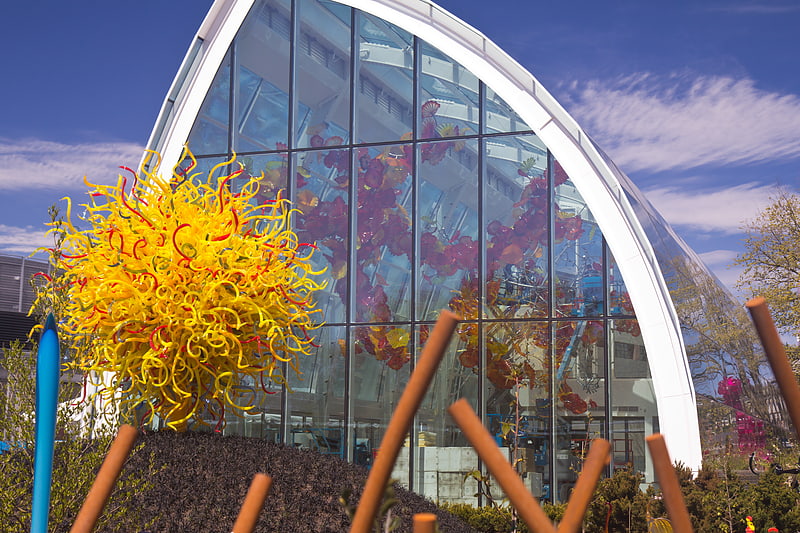
Art museum in Seattle, Washington. Chihuly Garden and Glass is an exhibit in the Seattle Center directly next to the Space Needle, showcasing the studio glass of Dale Chihuly. It opened in May 2012 at the former site of the defunct Fun Forest amusement park.
The project features three primary components: the Garden, the Glasshouse, and the Interior Exhibits, with significant secondary spaces including a 90-seat café with additional outdoor dining, a 50-seat multi-use theater and lecture space, retail and lobby spaces, and extensive public site enhancements beyond the Garden. The 100-foot-long installation inside of the Glasshouse is one of Chihuly's largest suspended sculptures. Designed with the help of architect Owen Richards, the facility was awarded LEED silver certification from the USGBC.[26]
Address: 305 Harrison Street, 98109-4623 Seattle
Alaskan Way Viaduct
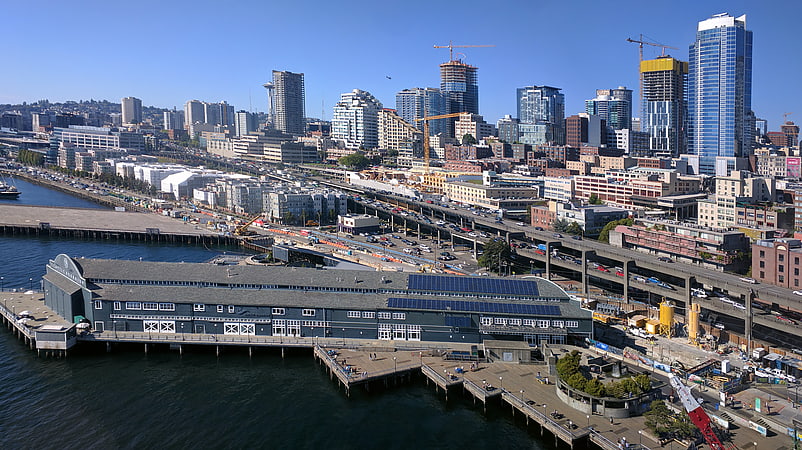
Viaduct in Seattle, Washington. The Alaskan Way Viaduct was an elevated freeway in Seattle, Washington, United States, that carried a section of State Route 99. The double-decked freeway ran north–south along the city's waterfront for 2.2 miles, east of Alaskan Way and Elliott Bay, and traveled between the West Seattle Freeway in SoDo and the Battery Street Tunnel in Belltown.
The viaduct was built in three phases from 1949 through 1959, with the first section opening on April 4, 1953. It was the smaller of the two major north–south traffic corridors through Seattle (the other being Interstate 5), carrying up to 91,000 vehicles per day in 2016. The viaduct ran above Alaskan Way, a surface street, from S. Nevada Street in the south to the entrance of Belltown's Battery Street Tunnel in the north, following previously existing railroad lines.
The viaduct had long been viewed as a barrier between downtown and the city's waterfront, with proposals to replace it as early as the 1960s. Questions of the structure's seismic vulnerability were raised after several earthquakes damaged similar freeways in other cities, including some with the same design as the viaduct. During the 2001 Nisqually earthquake, the Alaskan Way Viaduct suffered minor damage but later inspections found it to be vulnerable to total collapse in the event of another major earthquake, necessitating its replacement.
The state and city governments considered several options, including a rebuilt elevated structure, a surface boulevard, and cut-and-cover tunnel, but could not compromise on a final choice. A deep-bored tunnel was selected in 2009 and the southern section of the viaduct was demolished in 2011 and replaced with a six-lane, single-deck freeway that travels through the SoDo industrial area. Excavation of the downtown bored tunnel by the tunnel boring machine "Bertha" began in 2013 and was completed in 2017 after two years of delays. The viaduct was closed permanently on January 11, 2019, and the new tunnel opened three weeks later on February 4. Demolition of the viaduct began weeks later, and was complete by late 2019.[27]
Kerry Park
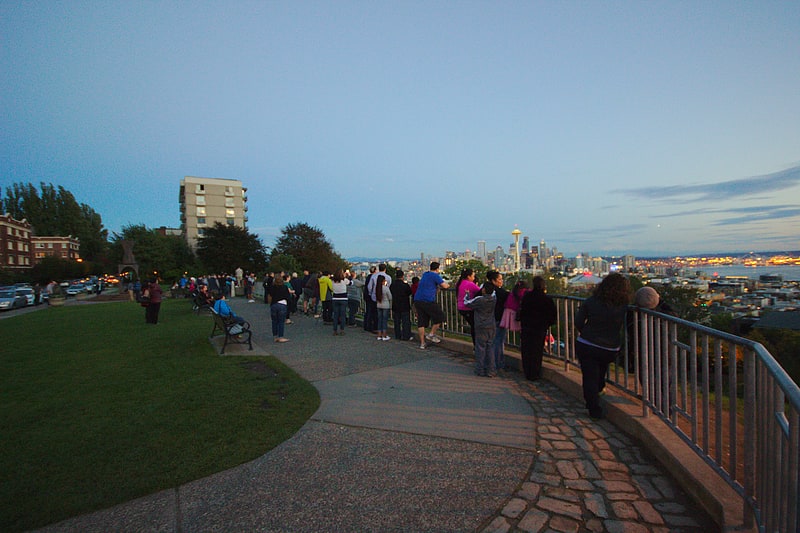
Park in Seattle, Washington. Kerry Park is a small public park and viewpoint on the south slope of Queen Anne Hill in Seattle, Washington, United States. It overlooks Downtown Seattle and is located along West Highland Drive between 2nd Avenue West and 3rd Avenue West. The park's view is considered to be the most iconic views of the city skyline, with the Space Needle prominent at the center, Elliott Bay to the west, and Mount Rainier in the background.
The park encompasses 1.26 acres (0.51 ha) and includes a railing and several benches facing south towards the skyline. A stairway on the west end of the park connects below to West Prospect Street and the Bayview-Kinnear Park, which has a small playground. Kerry Park is named after the couple lumberman and business magnate Albert S. Kerry and his wife Katharine. They lived nearby, and donated the land to the city in 1927 "so that all who stop here may enjoy view."
At the center of Kerry Park is Changing Form, a steel sculpture by artist Doris Totten Chase that stands 15 feet (4.6 m) high and was installed in 1971 with donations from Kerry's children. The sculpture is hollow and is popular as a play area for children and as a framing device for photographers. That view from Kerry Park encompasses downtown Seattle, Elliott Bay, the West Seattle peninsula, Bainbridge Island, and Mount Rainier.
The view from the park is often used as the backdrop for television news segments on Seattle, as well as other media depictions of the city. Kerry Park was also featured in the opening credits of the 1999 film 10 Things I Hate About You, and in Frasier as the view from the titular character's apartment.[28]
Address: 250 W Highland Dr, 98119-3529 Seattle
Mariners Team Store

Museum in Seattle, Washington. The Seattle Mariners Hall of Fame is an American museum and hall of fame for the Seattle Mariners of Major League Baseball. It is located at T-Mobile Park in the SoDo district of downtown Seattle.[29]
Address: 1250 1st Ave S, 98134 Seattle (Greater Duwamish)
Graves of Bruce and Brandon Lee
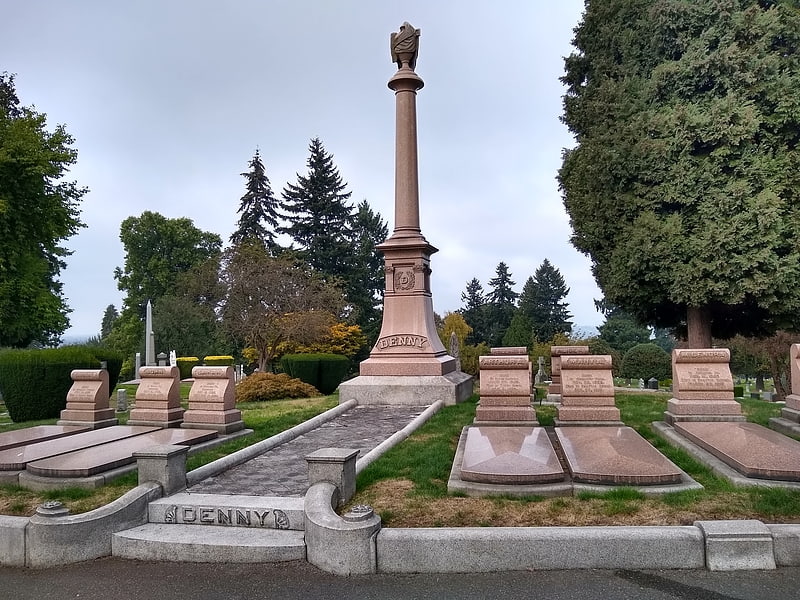
Cemetery in Seattle, Washington. Lake View Cemetery is a private cemetery located in Seattle, Washington, in the Capitol Hill neighborhood, just north of Volunteer Park. Known as "Seattle's Pioneer Cemetery," it is run by an independent, non-profit association. It was founded in 1872 as the Seattle Masonic Cemetery and later renamed for its view of Lake Washington to the east.[30]
Westlake Park
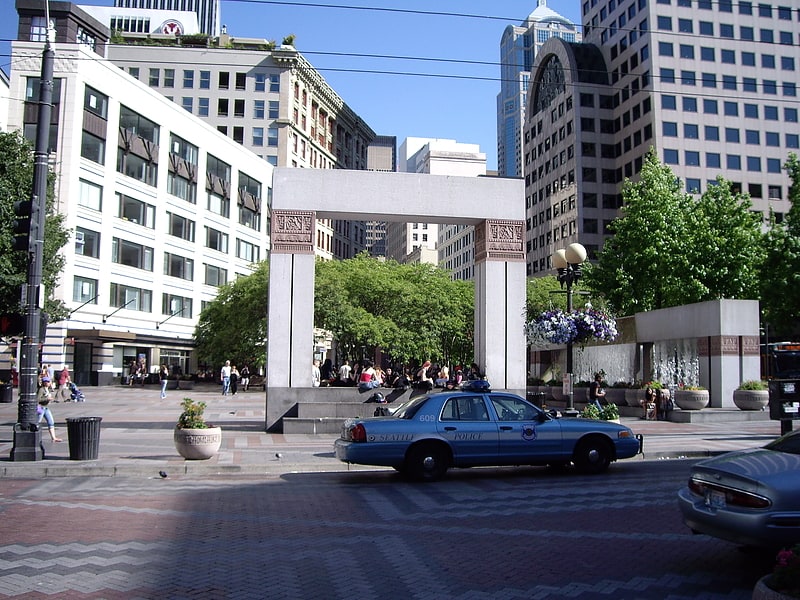
Park in Seattle, Washington. Westlake Park is a 0.1-acre public plaza in downtown Seattle, Washington, United States. It was designed by Robert Mitchell Hanna. Extending east from 4th Avenue up to and including a former portion of Westlake Avenue between Pike and Pine streets, it is located across Pine Street from the Westlake Center shopping mall and Westlake station, a major monorail and light rail hub. The park and mall are named for Westlake Avenue, which now terminates north of the mall, but once ran two blocks farther south to Pike Street through the present site of the mall and park. Westlake Park is considered Seattle's "town square", and celebrities and political figures often make appearances or give speeches from the four-story shopping center's balcony.
The city first proposed a pedestrian mall in 1959 between Pike and Stewart Streets. The southernmost block of Westlake Avenue (between Pike and Pine) was closed to traffic in the early 1960s to construct the original southern terminus of the Monorail. This arrangement continued from the time the Monorail opened in 1962 (in conjunction with the Century 21 Exposition) until the construction of the current mall and park.
The current park and mall were proposed by the Central Association (now Downtown Seattle Association) in 1968; they took 20 years to come to fruition. Multiple lawsuits were filed throughout this time and continued after the park's opening in October 1988. The project was marred by a design flaw, the so-called "Nightmare on Pine Street", that resulted in cracked granite pavers along Pine Street and into the intersection with Fourth Avenue. The city sued the designer and won an out-of-court settlement of $515,000, enough to cover the $472,000 repair and nearly equal to the cost of the original installation. Repairs began in June 1989.
After the pavers were repaired and the Downtown Seattle Transit Tunnel was completed in 1990, Seattle City Council decided to keep Pine Street closed to through traffic, making it effectively part of the park, and tying the park to the open area on the south side of the mall. However, Seattle citizens voted in 1995 to reopen the street, as part of a deal under which Nordstrom took over the flagship store of the former Frederick & Nelson department store chain, a city landmark half a block from the park. In the mid-1990s Westlake Park was the site of a string of guerrilla art pranks led by Jason Sprinkle and the Fabricators of the Attachment, culminating in an infamous bomb scare incident that closed off several downtown blocks.
Adjacent to the southernmost portion of the park is the Seaboard Building, another designated Seattle landmark. This 1909 headquarters of the Northern Bank & Trust Co. was one of the first major commercial buildings this far north in the downtown area. The ground floor is commercial space, Floors 2 through 6 are offices, and Floors 7 through the 11th floor penthouse are now condominium apartments. Diagonally across from the park at 4th and Pine, until its closure in February 2020, was a Macy's department store - another designated landmark building, having once been the flagship store of the Bon Marché chain.[31]
Address: 1698 Westlake Ave, 98101 Seattle (Downtown Seattle)
Golden Gardens Park
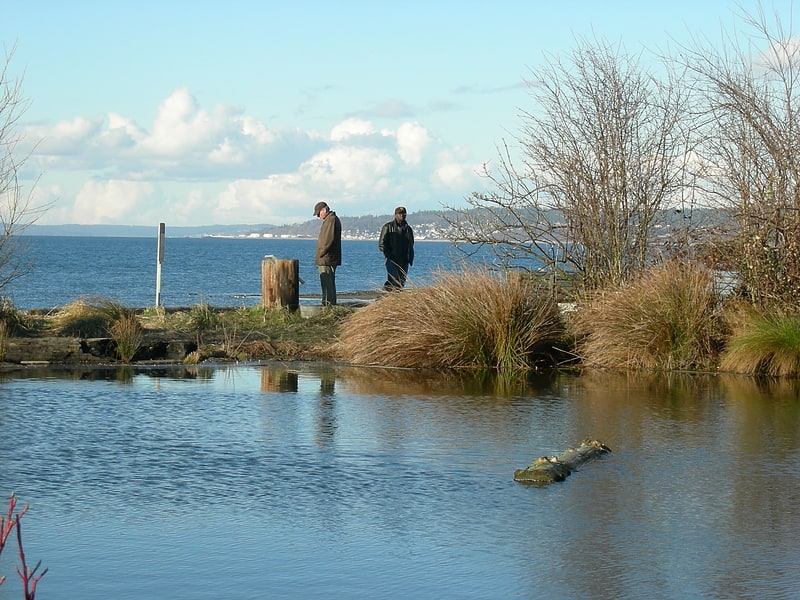
Park in Seattle, Washington. Golden Gardens Park is a public park in Ballard, a neighborhood of Seattle, Washington. The park includes wetlands, beaches, hiking trails, and picnic and playground areas. The park's bathhouse was designated a historic landmark by the City of Seattle in 2005.[32]
Address: 8499 Seaview Place NW, 98117 Seattle
Elliott Bay Marina
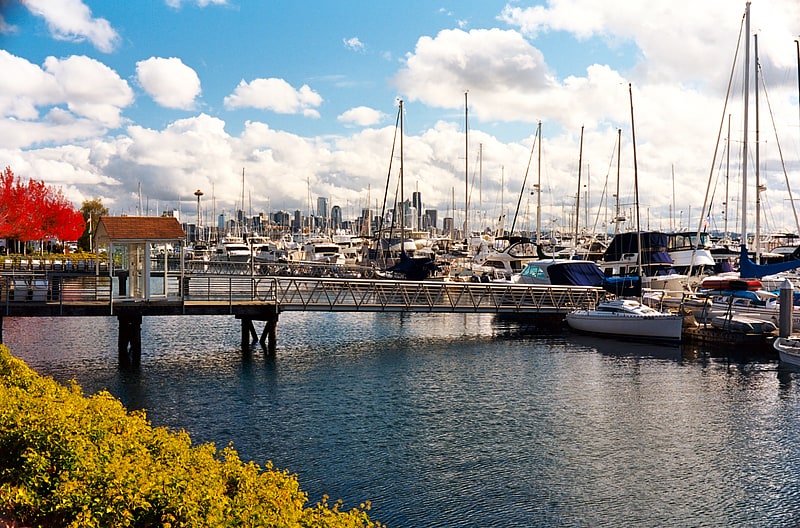
Marina in Seattle, Washington. Elliott Bay Marina is a private marina located in Seattle, Washington. It opened in 1991, after 17 years in the planning and permit process. There are 1,200 slips available for moorage. There is a stationary pumpout located on the fuel dock. The facility also has a Porta-Potty dump station.
The slips range in size from 32 to 63 feet with 52% of the boats between 36 and 50 feet LOA. The boat types are evenly split between sailboats and powerboats, which reflects the great sailing conditions on Puget Sound. Forty boats are liveaboards. Another 60 slips must remain available for transient boaters per agreement with the city.
The marina hosts the Downtown Sailing Series on Thursday nights during the summer.[33]
West Point Light
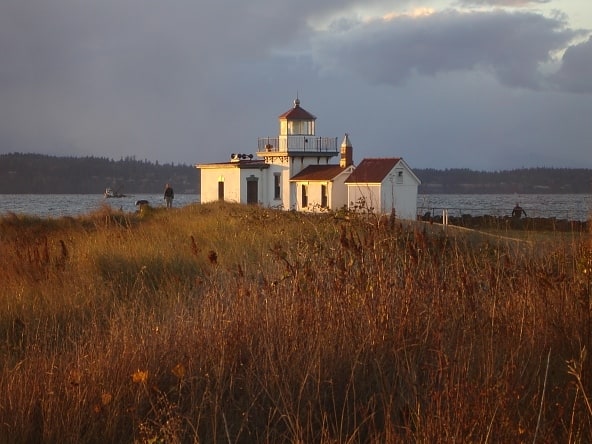
Lighthouse in Seattle, Washington. The West Point Light, also known as the Discovery Park Lighthouse, is an active aid to navigation on Seattle, Washington's West Point, which juts into Puget Sound and marks the northern extent of Elliott Bay. The lighthouse is similar in design to the Point No Point Light and was added to the National Register of Historic Places in 1977. It is a main feature of Seattle's Discovery Park.[34]
Henry Art Gallery
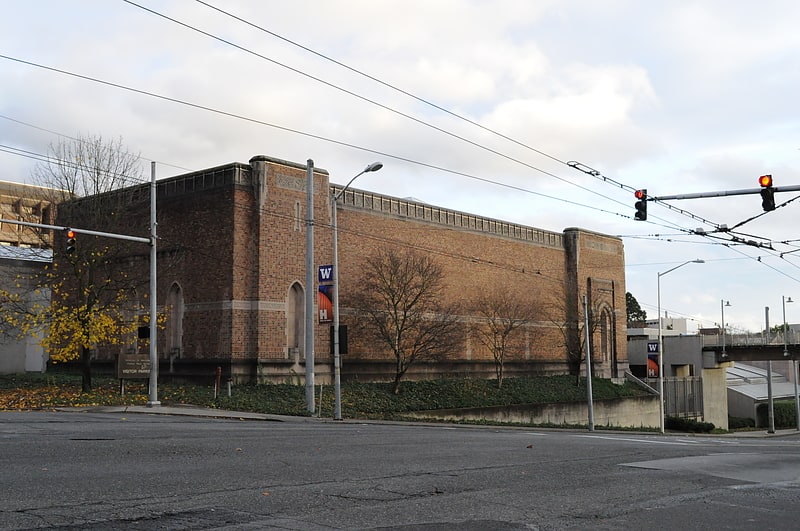
Art museum in Seattle, Washington. The Henry Art Gallery is the art museum of the University of Washington in Seattle, Washington, USA. Located on the west edge of the university's campus along 15th Avenue N.E. in the University District, it was founded in February, 1927, and was the first public art museum in the state of Washington. The original building was designed by Bebb and Gould. It was expanded in 1997 to 40,000 square feet, at which time the 154-seat auditorium was added. The addition/expansion was designed by Gwathmey Siegel & Associates Architects.[35]
Address: 15th Avenue NE and NE 41st St, 98195-0001 Seattle (Northeast Seattle)